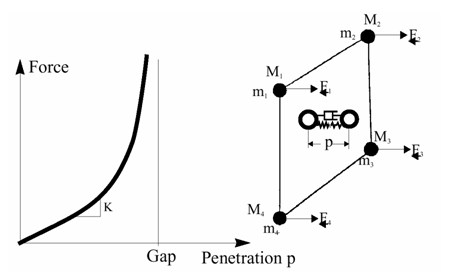Interface Stiffness

Figure 1. Interface Force Variation in Interface TYPE7
Nodal time step can be seriously affected if penetration is large. The stiffness, used to compute the nodal time step takes into account the interface stiffness.
- Increasing the gap
- Increasing the initial stiffness (through the use of the flag Stfac)
Both methods allow absorbing more energy by contact and smoothing the impact. Increasing the gap will allow nodes to slow down over a larger distance, therefore the penetration is reduced.
Comments
- Even if an elementary time step is chosen for the simulation, a nodal time step is automatically computed if there is an interface TYPE7. The lowest time step is applied for the simulation.
- Contrary to interface TYPE5, a Stfac smaller than 1.0 produces a large penetration at the first touch and results in
high interface stiffness and reaction force. To avoid high penetration, a Stfac greater than or equal to 1.0 is recommended.

Figure 2. Force vs. Penetration CurvesAlthough, increasing the initial stiffness leads to a smaller time step at the beginning of the penetration, it will increase the time step if penetration is large.